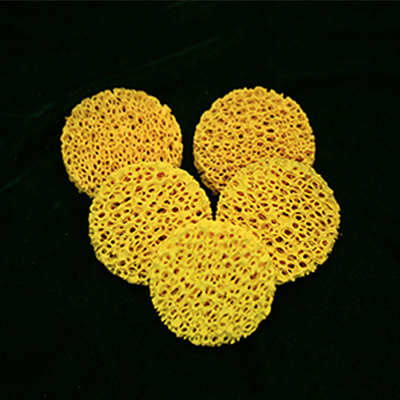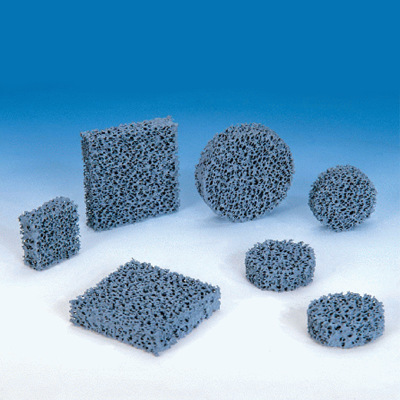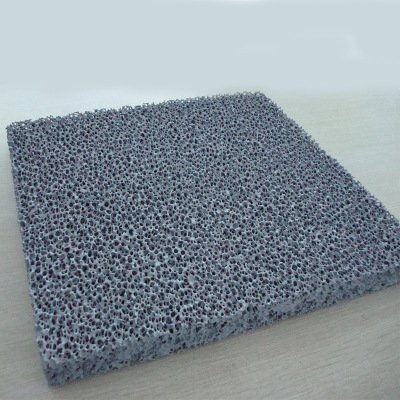Ceramic foam
The development of foam ceramic materials began in the 70s of the 20th century and is a porous material with high-temperature characteristics. Its pore size varies from millimeter to micron, porosity is between 20%~95%, and the operating temperature is room temperature ~1600°C
Category
Foam ceramics can generally be divided into two categories, open-cell (reticulated) ceramic materials and closed-cell ceramic materials, depending on whether the individual cavities have solid walls. If the solid that forms the foam body is only contained in the pore edge, it is called an open-cell ceramic material, and its pores are interconnected; If a solid wall is present, the foam body is called a closed-cell ceramic material, where the pores are separated from each other by a continuous ceramic matrix. However, most foam ceramics have both open pores and a small number of closed pores. Generally speaking, microporous materials with a pore diameter of less than 2 nm are considered microporous materials; Mesoporous materials with pores between 2~50nm; Porosity above 50nm is a macroporous material.
Overview of foreign developments
Since 1978, the United States invented the use of alumina, kaolin and other ceramic slurries to successfully develop foam ceramics for aluminum alloy casting filtration, Britain, Japan, Germany, Switzerland and other countries have competed to carry out research, the production process is increasingly technical equipment to mechanization, automation development, has developed a variety of materials, suitable for different purposes of foam ceramic filters, such as A12O3, ZrO2, SiC, silicon nitride, boride and other high-temperature foam ceramics, some also added a certain minerals, such as mullite, Iolite, fly ash, coal gangue, etc., the products have been serialized and standardized, forming a new industry, and its classification is shown in the table.
The state of development of our country
In the early 80s of the 20th century, China carried out research on foam ceramics. In the past 20 years, more than a dozen scientific research institutions and manufacturers have reported the research on foam ceramic products. However, there is still a certain gap between China's foam ceramics and foreign countries in terms of overall technical level. Foam ceramics are porous ceramics with high porosity with three-dimensional space grid structure, and their shapes are like tempered foam plastics or porcelainized sea foam ceramics Classified material types Aggregate Corrosion Resistance Temperature (°C) High siliceous silicate material Porcelain slag Water resistance, acid resistance 700 Aluminosilicate material Clay clinker Weak alkali resistance, acid resistance 1 000 Corundum corundum material Fused corundum Water resistance, acid resistance 1 600 Diatomaceous earth Clay Water resistance, acid resistance Low temperature Cotton. Because it has high porosity, large specific surface area, thermal shock resistance, high temperature resistance, chemical corrosion resistance and good mechanical strength and filtration and adsorption properties, it can be widely used in heat exchange materials, gas distribution materials, automobile exhaust devices, purification metallurgical industry filtration molten metals, heat energy recovery, light industry spraying industry, industrial sewage treatment, heat and sound insulation materials, used as chemical catalyst carriers, electrolytic diaphragms and separation and dispersion elements.
Apply
In recent years, the application fields of porous ceramics have been extended to the fields of aviation, electronics, medical materials and biochemistry. The wide application of porous ceramics has attracted great attention from the global material community, therefore, it is undoubtedly necessary to prepare foam ceramics with high strength, uniform pore size, stable performance and high order, and to broaden and develop the application of foam ceramics in various industries in China.
Traditional preparation methods
1.1 The foaming method adopts the method of foaming reaction, which can prepare foam ceramic products with complex shapes to meet the application of some special occasions; The addition of appropriate ceramic fibers to the ceramic powder can improve the process, effectively increase the strength of the green body during the sintering process, and avoid pulverization and collapse.
1.2 Sol-gel methodThe sol-gel method is mainly used to prepare microporous ceramic materials with pore sizes in the nanometer scale, and this method can also be improved to prepare high-regularity foam ceramic materials. In the process of sol-to-gel conversion process, the viscosity of the system increases rapidly, thereby stabilizing the bubbles generated in the early stage and facilitating foaming.
1.3 The method of adding pore-forming agent prepares foam ceramics by adding pore-forming agent to the ceramic batching, using the pore-forming agent to occupy a certain space in the green body, and then sintering and forming pores after the pore-forming agent leaves the matrix. The shape and size of the pore-forming agent particles determine the shape and size of the pores of the foam material. Its molding methods mainly include molding, extrusion, isostatic pressing, rolling, injection and slurry pouring. This method can be used to prepare materials with complex shapes and different pore structures, but the uniformity of stomatal distribution is poor.
1.4 Organic precursor impregnation method At present, the most ideal preparation method for foam ceramics is organic precursor impregnation method, and its process flow is shown in the figure. The foam ceramics prepared by this molding method have been widely used in many fields, and obvious results have been obtained. Further control of slurry performance, appropriate optimization of inorganic binder system, and strict control of slurry impregnation and other processes can improve the performance of foam ceramic products. Ceramic powder solvents, additives - > slurry preparation of organic foam selection - > pretreatment == > impregnation treatment - > removal of excess slurry - > drying - > exclusion of organic foam - > firing However, there is an obvious defect in the organic precursor impregnation process, that is, the pore structure of the product, especially the pore size, depends on the pore structure and pore size of the selected organic foam. At present, the mesh size of the selected organic foam is limited, which restricts the pore size and structure of the obtained foam ceramic material. Zhu Xinwen et al. used three-dimensional mesh organic foam as the carrier, and first prepared a mesh blank with high porosity and almost no hole blocking by impregnation process, and obtained a prefabricated body with a certain strength through plastic discharge and pre-firing treatment. The pore edge of the prefabricated body has a loose porous structure, which solves this problem well.
Emerging processes 2.1 Gel Injection Molding ProcessOak Ridge Laboratory in the United States proposed the gel injection molding process (Gel-casting) for the first time, which is a new molding method that is widely used. This new molding technology uses a non-porous mold, which uses the chemical reaction inside the slurry or a small amount of additives to solidify the ceramic slurry in situ to form a green body, and obtain a plain blank with good microscopic uniformity and high density, thereby significantly improving the feasibility of the material. The gel-casting process can foam the suspended body and the liquid foam can be polymerized and solidified in situ. As a new method for the preparation of porous ceramics, the foaming of suspended bodies is the most economical, and the blank formed by in-situ polymerization and solidification has an internal network structure and high strength.
2.2 Self-propagating High-tempera-ture Synthesis (SHS) The concept of self-propagating high-temperature synthesis (SHS) method was first proposed by the former Soviet scientist A.G. Mazhanov in 1967. The essence of SHS is a highly exothermic inorganic chemical reaction, and its basic reaction process is: to provide the necessary energy (ignition) to the system, induce a local chemical reaction in the system, after that, this chemical reaction process continues with the support of the high heat released by itself, and finally spreads the combustion (reaction) wave to the whole system, so as to prepare the required ceramic materials. The SHS technology of materials is highly valued for its high efficiency, energy saving, economy and good performance characteristics of the resulting materials. In addition, the SHS reaction products usually have high porosity, which can be used to prepare ceramic materials with porous continuous network structure, and the connected open porosity of the products can be further improved by adding pore-forming agents. In addition, there are foam precursor reaction method, organic foam accumulation method, particle accumulation process, hydrothermal-thermostatic pressing process, microwave heating process, split-phase filtration method, solid-gas eutectic method, wood thermal destructuring and other foam ceramic preparation methods.
Application of ceramic foam
Fields of application
The application of foam ceramics began in the 70s of the 19th century, when they were only used as uranium purification materials and bacterial filter materials. With the continuous expansion of the use of foam ceramics, its application fields have gradually expanded, from filtration, thermal engineering and other fields to heat insulation, sound absorption, electronics, optoelectronics, sensing, environmental biology and chemistry.
Hot Industries
3.1 The advantages of microporous membrane ceramic separation membrane have been recognized by people for their acid and alkali resistance, erosion resistance, high temperature resistance, aging resistance, long service life, etc., and have been developed and used in many fields such as food industry, biochemical industry, energy engineering, environmental engineering, electronic technology, etc. With the development of materials science, the preparation and application of nanoscale porous inorganic membranes have become a hot topic of research.
3.2 BiomaterialsAt present, many scientific research institutes are committed to the research of porous hydroxyapatite bioceramic materials. Porous hydroxyapatite bioceramics were prepared by adding pore-forming agents and making foam ceramics, and their interconnected pores were conducive to the microcirculation of tissue fluid and promoted the infiltration and growth of cells. At present, the developed foam ceramic hydroxyapatite artificial bone and prosthetic eye have been used in clinical experiments, which have attracted the attention of the medical community and the materials science community.
3.3 Foam ceramics for food and health industry Foam ceramics can be used for the concentration, separation and refining of physiologically active substances such as enzymes, viruses, vaccines, nucleic acids, proteins and other physiologically active substances in the pharmaceutical industry due to their high temperature resistance, corrosion resistance and good biological and chemical properties. In the food and beverage industry, it is especially suitable for the filtration of beverages with high requirements for color, aroma and taste, and low-alcohol alcohol, and is expected to play a huge role in the production of beer.
3.4 Environmental materials With the development of modern industry, all walks of life emit more and more harmful gases and wastewater in production, if not properly treated, it will seriously affect the living environment of human beings, so environmental protection has become the theme of the times. Foam ceramics have been used in automotive catalytic converters for a long time. The foam ceramic catalytic converter for deodorization can catalyze the combustion of organic solvents and odorous gases in wastewater to achieve the purpose of deodorization and purification. The use of high-permeability foam with high temperature resistance and sufficient strength to resist thermal shock can effectively remove high-temperature dust-containing gases. In the process of urban sewage treatment, foam ceramic materials have also become the materials used in aeration treatment.
3.5 Thermal insulation materialFoam ceramic has the characteristics of low thermal conductivity and thermal shock resistance, and is an ideal heat-resistant material. The typical heat-resistant material made of foam ceramic is heat-resistant brick, which is made of Zr02, SiC, magnesium salt and calcium salt, etc., with a service temperature of up to 1600 °C, which is currently the world's thermal insulation material, called "super thermal insulation material", which is used in the thermal insulation of the space shuttle shell and the thermal insulation of the missile head.


